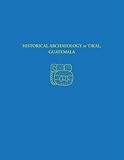Historical Archaeology at Tikal, Guatemala : Tikal Report 37 / Hattula Moholy-Nagy.
Material type: TextPublisher: Philadelphia : University of Pennsylvania Press, [2012]Copyright date: ©2012Description: 1 online resource (120 p.) : 29 illusContent type:
TextPublisher: Philadelphia : University of Pennsylvania Press, [2012]Copyright date: ©2012Description: 1 online resource (120 p.) : 29 illusContent type: - 9781934536476
- 9781934536582
- 972.81/2
- online - DeGruyter
- Issued also in print.
| Item type | Current library | Call number | URL | Status | Notes | Barcode | |
|---|---|---|---|---|---|---|---|
 eBook
eBook
|
Biblioteca "Angelicum" Pont. Univ. S.Tommaso d'Aquino Nuvola online | online - DeGruyter (Browse shelf(Opens below)) | Online access | Not for loan (Accesso limitato) | Accesso per gli utenti autorizzati / Access for authorized users | (dgr)9781934536582 |
Browsing Biblioteca "Angelicum" Pont. Univ. S.Tommaso d'Aquino shelves, Shelving location: Nuvola online Close shelf browser (Hides shelf browser)

|

|

|

|

|

|

|
||
| online - DeGruyter The New Chronology of Iron Age Gordion / | online - DeGruyter Literacy in the Persianate World : Writing and the Social Order / | online - DeGruyter The Extramural Sanctuary of Demeter and Persephone at Cyrene, Libya, Final Reports, Volume VIII : The Sanctuary's Imperial Architectural Development, Conflict with Christianity, and Final Days / | online - DeGruyter Historical Archaeology at Tikal, Guatemala : Tikal Report 37 / | online - DeGruyter The Archaeology of Phrygian Gordion, Royal City of Midas : Gordion Special Studies 7 / | online - DeGruyter Evolution of Mind, Brain, and Culture / | online - DeGruyter Hasanlu V : The Late Bronze and Iron I Periods / |
Frontmatter -- Contents -- Appendices -- Figures -- Tables -- Acknowledgments -- Abbreviations -- 1. Introduction -- 2. Settlement Pattern and Scattered Finds -- 3. Material Culture -- Appendix E. Published Records of Visits to Tikal, 1696-1956 -- Appendix F. Letter from Edwin M. Shook to Hattula Moholy-Nagy -- Appendix G. Letter from Dennis E. Puleston to Hattula Moholy-Nagy -- Appendix H. Notes on San José Material Culture of the Late 1950s-Early 1960s -- Appendix I. Professor Walter M. Wolfe's Trip to Tikal, 1901 -- Appendix J. Research on the Bottles of Tikal by Paul S. Newton -- Appendix K Salvador Valenzuela's Report on the Department of Petén, 1879 (Valenzuela 1951) -- References -- Summary in Spanish -- Figures -- Tables -- Index
restricted access online access with authorization star
http://purl.org/coar/access_right/c_16ec
The pre-Columbian city we call Tikal was abandoned by its Maya residents during the tenth century A.D. and succumbed to the Guatemalan rain forest. It was not until 1848 that it was brought to the attention of the outside world. For the next century Tikal, remote and isolated, received a surprisingly large number of visitors. Public officials, explorers, academics, military personnel, settlers, petroleum engineers, chicle gatherers, and archaeologists came and went, sometimes leaving behind material traces of their visits. A short-lived hamlet was established among the ancient ruins in the late 1870s. In 1956 the University of Pennsylvania Museum of Archaeology and Anthropology initiated its fourteen-year-long Tikal Project.This report chronicles documented visits to Tikal during the century following its modern discovery, and presents the post-Conquest material culture recovered by the Tikal Project in the course of its investigation of the pre-Columbian city. Further research on the nineteenth-century settlement was carried out in 1998 in its southern part by the Lacandon Archaeological Project (LAP) under the direction of Joel W. Palka of the University of Illinois at Chicago. The material culture recovered by the LAP supplements the Tikal Project collection and is referenced here. Historical Archaeology at Tikal, Guatemala is intended as a contribution to nineteenth and early twentieth century Lowland Mesoamerican research. It is rounded out with several appendices that will be of interest to historians and historical archaeologists.The printed volume includes many black and white photographs and drawings. A gallery of color photographs, several from Palka's 1998 excavations, is included on the accompanying CD-ROM. Content of the book's CD-ROM may be found online at this location: http://core.tdar.org/document/376606.University Museum Monograph, 135
Issued also in print.
Mode of access: Internet via World Wide Web.
In English.
Description based on online resource; title from PDF title page (publisher's Web site, viewed 24. Apr 2022)


